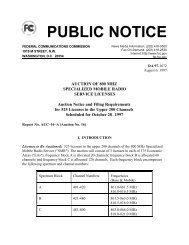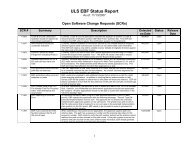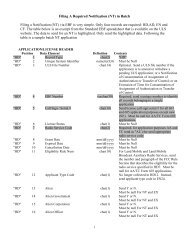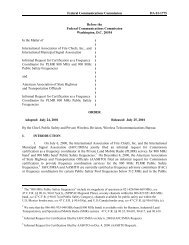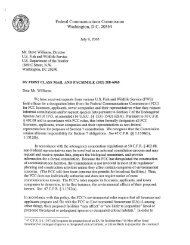Ausubel, et al - FCC
Ausubel, et al - FCC
Ausubel, et al - FCC
Create successful ePaper yourself
Turn your PDF publications into a flip-book with our unique Google optimized e-Paper software.
Comments on Experiment<strong>al</strong> Design for Ev<strong>al</strong>uating <strong>FCC</strong> Spectrum Auction Alternatives<br />
Lawrence M. <strong>Ausubel</strong>, P<strong>et</strong>er Cramton, and Paul Milgrom<br />
1 June 2005<br />
We are responding to Public Notice DA 05-1267, which seeks comment on the proposed<br />
experiment<strong>al</strong> design to ev<strong>al</strong>uate aspects of the <strong>FCC</strong>’s <strong>al</strong>ternative auction m<strong>et</strong>hods, both with and<br />
without package bidding. The experiment<strong>al</strong> design is ambitious. Our main comment is that the<br />
effort will be more productive if there is more focus on elements for which past experience and<br />
existing knowledge does not provide adequate support with which to make a selection.<br />
Major comment: Test the clock and clock-proxy auction designs<br />
We believe it is a mistake to focus <strong>al</strong>l attention on the simultaneous multiple round auction<br />
(with and without package bids), given that there is substanti<strong>al</strong> theory and experience suggesting<br />
that a clock auction or clock-proxy auction would perform b<strong>et</strong>ter in the <strong>FCC</strong> s<strong>et</strong>ting.<br />
There are sever<strong>al</strong> advantages to the clock implementation, described in greater d<strong>et</strong>ail in our<br />
paper, “The Clock-Proxy Auction: A Practic<strong>al</strong> Combinatori<strong>al</strong> Auction Design.” Some of our<br />
other references related to clock auctions and proxy auctions are listed at the end of this<br />
Comment.<br />
The clock auction is a simpler process than the simultaneous ascending auction. Bidders are<br />
provided the minim<strong>al</strong> information needed for price discovery—the prices and the excess<br />
demand. Bidders are not distracted by other information that is either extraneous or potenti<strong>al</strong>ly<br />
useful as a means to facilitate collusion.<br />
The clock auction <strong>al</strong>so can take b<strong>et</strong>ter advantage of substitutes, for example, using a single<br />
clock for items that are near perfect substitutes. In spectrum auctions, there is a tendency for the<br />
<strong>FCC</strong> to make specific band plans to facilitate the simultaneous ascending auction. For example,<br />
anticipating demands for a large, medium, and sm<strong>al</strong>l license, the <strong>FCC</strong> may specify a band plan<br />
with three blocks—30 MHz, 20 MHz, and 10 MHz. Ide<strong>al</strong>ly, these decisions would be left to the<br />
bidders themselves. In a clock auction, the bidders could bid the number of 2-MHz blocks<br />
desired at the clock price. Then the auction would d<strong>et</strong>ermine the band plan, rather than the <strong>FCC</strong>.<br />
This approach is more efficient and would likely be more comp<strong>et</strong>itive, because <strong>al</strong>l bidders are<br />
comp<strong>et</strong>ing for <strong>al</strong>l the bandwidth in the clock auction. With the pres<strong>et</strong> band plan, some bidders<br />
may be uninterested in particular blocks, such as those that are too large for their needs. The<br />
proposed experiment<strong>al</strong> design does not address this important issue.<br />
Clock auctions are faster than a simultaneous ascending auction. Simultaneous ascending<br />
auctions are especi<strong>al</strong>ly slow near the end, when there is little excess demand. For example, when<br />
there are six bidders bidding on five similar licenses, then it typic<strong>al</strong>ly takes five rounds to obtain<br />
a one bid-increment increase on <strong>al</strong>l items. In contrast, in a clock auction, an increment increase<br />
takes just a single round. Moreover, intra-round bids <strong>al</strong>low larger increments, without<br />
introducing inefficiencies, because bidders still can express demands <strong>al</strong>ong the line segment<br />
from the start-of-round prices to the end-of-round prices.<br />
The clock auction limits collusion relative to the simultaneous ascending auction. Sign<strong>al</strong>ing<br />
how to split up the items is greatly limited. Collusive strategies based on r<strong>et</strong><strong>al</strong>iation are not<br />
possible, because bidder-specific quantity information is not given. Further, the simultaneous<br />
ascending auction can have a tendency to end early when an obvious split is reached, but this<br />
1
cannot happen in the clock auction, because the bidders lack information about the split. Also<br />
there are fewer rounds to coordinate a split. The proposed experiment<strong>al</strong> design does address this<br />
issue by considering two information policies.<br />
The clock auction can be implemented as a package auction and thus eliminate the exposure<br />
problem. This is accomplished by l<strong>et</strong>ting a bidder reduce quantity on other items as long as at<br />
least one price increases. The bid is binding only as a full package. Hence, the bidder can safely<br />
bid for synergistic gains.<br />
The clock auction d<strong>et</strong>ermines minimum bids for packages that are different from those<br />
imposed by some versions of the SMRPB design and easier for human bidders to anticipate and<br />
understand. Minimum bids for packages are necessary to compl<strong>et</strong>e complex auctions with many<br />
goods in a reasonable amount of time, and <strong>al</strong>l rules that are effective in speeding the auction<br />
necessarily risk impairing efficiency of the auction outcomes. The advantage of the clock rule<br />
over other minimum bid rules is its simplicity and predictability, which should make it the<br />
leading candidate for a package bidding design.<br />
The main advantage of the proxy phase is that it pushes the outcome toward the core, that is,<br />
toward an efficient <strong>al</strong>location with comp<strong>et</strong>itive payoffs for the bidders and comp<strong>et</strong>itive revenues<br />
for the seller.<br />
In the proxy phase, there are no incentives for demand reduction. A large bidder can bid for<br />
large quantities without the fear that doing so will adversely impact the price the bidder pays.<br />
The proxy phase <strong>al</strong>so mitigates collusion. Any collusive split of the items established in the<br />
clock phase can be undone in the proxy phase. A relaxed activity rule means that the bidders can<br />
expand demands in the proxy phase. The <strong>al</strong>location is still up for grabs in the proxy phase.<br />
Given these advantages of the clock auction and clock-proxy auction, we believe it would be<br />
more productive to test the clock-based designs earlier, rather than later. Indeed, if there is only<br />
time or money to look at either clock or non-clock auctions, we recommend that the clock<br />
implementations be the focus.<br />
Minor comments<br />
We <strong>al</strong>so have a number of minor comments.<br />
We agree that the simplified approach with a single common v<strong>al</strong>ue sign<strong>al</strong> (eq. 1.2) is both<br />
simpler and more re<strong>al</strong>istic.<br />
We like the param<strong>et</strong>ric approach where the v<strong>al</strong>uation of a package depends on a few<br />
param<strong>et</strong>ers.<br />
In auctions where the licenses differ greatly in the population covered, the sc<strong>al</strong>e component<br />
is b<strong>et</strong>ter represented by the population covered rather than the number of licenses. However, in<br />
the context of the experiment it seems fine to have licenses about the same size.<br />
The v<strong>al</strong>uation model (eq. 1.3) is too simple to address the differing effects of geographic<br />
coverage and bandwidth. For example, it is common for bidders to have diminishing margin<strong>al</strong><br />
v<strong>al</strong>ue for bandwidth in a geographic area and y<strong>et</strong> increasing r<strong>et</strong>urns with greater geographic<br />
coverage. This is not possible with the proposed model.<br />
The experiment<strong>al</strong> design mentions budg<strong>et</strong> constraints, but then they are not considered in<br />
any of the treatments. We recommend against focusing on budg<strong>et</strong> constraints at this stage.<br />
2
Although bidders often have budg<strong>et</strong> constraints, we have never seen them take the simplistic<br />
form described in the experiment<strong>al</strong> design. Budg<strong>et</strong> constraints are more complex in practice than<br />
a single bright-line number. First, budg<strong>et</strong> constraints change over the auction. Often, there are<br />
multiple constraints, such as a $/pop for various license categories, constraints on intern<strong>al</strong> rate of<br />
r<strong>et</strong>urn, or an increasing cost of capit<strong>al</strong> with addition<strong>al</strong> expenditure.<br />
The study of revenue performance of the proposed design is underdeveloped. Revenue and<br />
efficiency performance are closely related to the an<strong>al</strong>ysis of wh<strong>et</strong>her outcomes are in the core<br />
(<strong>Ausubel</strong> and Milgrom 2002). The experiments should report not only on wh<strong>et</strong>her the outcome is<br />
in the core, but should compare auction revenues to the minimum seller revenues in the core and,<br />
as a diagnostic, should report which core inequ<strong>al</strong>ities fail in each treatment and by how much<br />
they fail.<br />
REFERENCES<br />
<strong>Ausubel</strong>, L., “An Efficient Ascending-Bid Auction for Multiple Objects,” American Economic<br />
Review, Vol. 94, No. 5, pp. 1452-1475, December 2004.<br />
<strong>Ausubel</strong>, L. and P. Cramton, “Demand Reduction and Inefficiency in Multi-Unit Auctions,” Working<br />
Paper No. 96-07, University of Maryland, July 2002.<br />
<strong>Ausubel</strong>, L. and P. Cramton, “Auctioning Many Divisible Goods,” Journ<strong>al</strong> of the European<br />
Economics Association, 2, 480-493, April-May 2004.<br />
<strong>Ausubel</strong>, L., P. Cramton, and P. Milgrom, “The Clock-Proxy Auction: A Practic<strong>al</strong> Combinatori<strong>al</strong><br />
Auction Design,” Chapter 5 in P<strong>et</strong>er Cramton, Yoav Shoham, and Richard Steinberg (eds.),<br />
Combinatori<strong>al</strong> Auctions, forthcoming, MIT Press, 2006.<br />
<strong>Ausubel</strong> L. and P. Milgrom, “Ascending Auctions with Package Bidding,” Frontiers of<br />
Theor<strong>et</strong>ic<strong>al</strong> Economics, Vol. 1: No. 1, Article 1 (August 2002).<br />
http://www.bepress.com/bejte/frontiers/vol1/iss1/art1.<br />
Milgrom, P., “Putting Auction Theory to Work: The Simultaneous Ascending Auction,” Journ<strong>al</strong> of<br />
Politic<strong>al</strong> Economy , Vol. 108, No. 2, pp. 245–72, 2000.<br />
Milgrom, P., Putting Auction Theory to Work , Cambridge University Press, 2004.<br />
3



